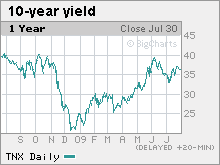Prices rise after a record weekly debt offering goes down with only mild indigestion. Investors brace for next week's refunding announcement.
NEW YORK (CNNMoney.com) -- Treasury prices rose Friday after a record week of debt sales ended on a high note, easing some fears that foreign demand for U.S. debt is wearing thin.
The government sold more than $200 billion in notes, bills and Treasury Inflation Protected Securities this week. It was the latest in a string of record-setting debt offerings that the U.S. has held monthly as the government seeks to fund a $1.8 trillion budget deficit.
Concerns about buyer fatigue were highlighted after this week's auctions of 2- and 5-year notes brought in fewer bids compared with last month's auctions of the securities. Indirect bids, which include foreign central banks, were also mixed this week.
Foreign demand: Many analysts are concerned that China and other Asian central banks, which are major buyers of U.S. debt, are losing their appetite for Treasurys. But those concerns were allayed after Thursday's auction of 7-year notes garnered a healthy share of indirect bidders.
"Anecdotally, it seems like we're getting pretty good support from foreign buyers," said Steve Van Order, fixed income strategist at Calvert Funds. He added that gauging foreign demand has been made more difficult due to a recent change in how the Treasury categorizes indirect bids.
Analysts said the successful 7-year auction bodes well for the government, which needs to continue borrowing billions of dollars to pay for its various economic stimulus efforts.
"What we've seen this last week in the market's ability to absorb issuance is that the U.S. will be able to float debt for the foreseeable future and will be able to fund its activities," said Joseph Brusuelas, a director at Moody's Economy.com.
But there are still questions about the long-term viability of this strategy, especially with the Obama administration's plans to restructure health care, improve education and combat climate change.
"At a certain point, the bond market will demand higher rates if the government's very ambitious spending programs are put into practice," he added.
Move into stocks: Meanwhile, investors have shifted money into stocks and corporate bonds after a string of better-than-expected corporate earnings reports and improved economic news.
The government said Friday that U.S. gross domestic product, the broadest measure of economic activity, fell at a smaller-than-expected rate in the second quarter.
Stocks ended the session nearly unchanged Friday, but Wall Street delivered its best July in decades.
Next week, the government will announce how much 3-,10- and 30-year debt it plans to auction off later in August.
"We may cheapen up the longer end of the curve in advance of that supply," Van Order said. The market is also gearing up for key economic indicators next week, such as the Labor Department's monthly jobs report.
"It's going to be potentially an interesting week," he said.
Bond prices: The benchmark 10-year note was up 1-2/32 to 97-3/32 and yielded 3.48%, down from 3.61% Thursday. Bond prices and yields move in different directions.
The 30-year bond jumped 1-29/32 to 99-7/32 and its yield sank to 4.30% from 4.42%.
The 5-year note edged up 17/32 to 100-17/32 and its yield was 2.52%.
The 2-year note advanced 4/32 to 99-25/32, and its yield was 1.12%.























